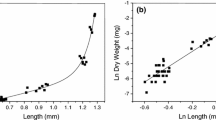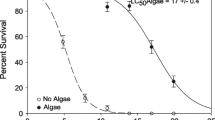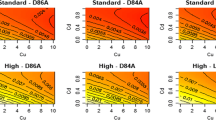Abstract
Populations ofDaphnia magna exposed to selenium as Na2SeO4 in water over a range of 0–1.0 mg Se/L and fed control algae showed decreased survival, reduced numbers of offspring, and a lower intrinsic growth rate (“r”) in a concentration-response manner.Daphnia fed algae grown in medium containing selenium when exposed to selenium in the water exhibited a reduced response with respect to these variables over the same concentration range. The uptake of75selenium from water was significantly reduced when theDaphnia were fed selenium-laden algae or when DL-selenomethionine was present in the water. The presence of organically bound selenium in the food or water appears to alter the rate of incorporation of inorganic selenium and reduces the toxic effects onDaphnia populations.
Similar content being viewed by others
References
Adams WJ, Johnson HE (1981) Selenium—a hazard assessment and a water quality criterion calculation. In: Branson DR, Dickson KL (eds) Aquatic toxicology and hazard assessment: Fourth conference. American Society of Testing Materials, pp 124–137
Andren AW, Klein DH (1975) Selenium in coal-fired steam plant emissions. Environ Sci Technol 9:856–858
Bennett WN, Brooks AS, Boraas ME (1986) Selenium uptake and transfer in an aquatic food chain. Arch Environ Contam Toxicol 15:513–517
Bertram PE, Brooks AS (1986) Kinetics of accumulation of selenium from food and water by fathead minnows. Water Res 20:877–884
Bertine KK, Goldberg ED (1971) Fossil fuel combustion and the major sedimentary cycle. Science 173:233–235
Biesinger KE, Christensen GM (1972) Effects of various metals on survival, growth, reproduction, and metabolism ofDaphnia magna. J Fish Res Board Can 29:1691–1700
Boyum KW (1984) The toxic effect of selenium on the zooplankton,Daphnia magna andDaphnia pulicaria, in water and the food source(Chlamydomonas reinhardtii). PhD dissertation, Department of Biological Sciences, University of Wisconsin—Milwaukee
Brooks AS (1984) Selenium in the environment: An old problem with new concerns. In: The effects of trace elements on aquatic ecosystems. EPRI EA-3319 Project 1931, Electric Power Research Institute, Palo Alto, CA
Caughley G (1971) Rate of increase. J Wildlife Mgmt 356:658–663
Copeland RA, Ayers JC (1972) Trace element distribution in water, sediment, phytoplankton, Zooplankton, and benthos of Lake Michigan: A baseline study with calculations of concentration factors and buildup of radioisotopes in the food web. Environmental Research Group Inc, Ann Arbor, MI
Cumbie PM, Van Horn SL (1978) Selenium accumulation associated with fish mortality and reporductive failure. Proc Ann Conf SE Assoc Fish and Wildl Agencies 32:612–624
Fries L (1982) Selenium stimulates growth of marine macroalgae in axenic culture. J Phycol 18:328–331
Frost DV, Lish PM (1975) Selenium in biology. Ann Rev Pharmacol 15:259–284
Hilton JW, Hudson PV, Slinger SJ (1980) The requirement and toxicity of selenium in rainbow trout (Salmo gairdnerf). J Nutr 110:2527–2535
Hodson PV, Spry DJ, Blunt BR (1980) Effects on rainbow trout (Salmo gairdneri) of a chronic exposure to waterborne selenium. Can J Fish Aquat Sci 37:233–240
Kleinow KM, Brooks AS (1986a) Selenium compounds in the fathead minnow (Pimephales promelas). I. Uptake distribution and elimination of orally administered selenate, selenite, and I-selenomethionine. J Comp Biochem and Physiol 83C:61–69
— (1986b) Selenium compounds in the fathead minnow(Pimephales promelas) II. Quantitative approach to gastrointestinal absorption, routes of elimination and influence of dietary pretreatment. J Comp Biochem and Physiol 83C:71–76
Kunselman GC, Huff EA (1976) The determination of arsenic, antimony, selenium, and tellurium in environmental water samples by flameless atomic absorption. Atomic Absorption Newslett 15:29–32
Lindstrom K (1983) Selenium as a growth factor for plankton algae in laboratory experiments and in some Swedish lakes. Hydrobiologia 101:35–48
McKeehan WL, Hamilton WG, Han RG (1976) Selenium is an essential trace nutrient for growth of W1-36 diploid human fibroblasts. Proc Natl Acad Sci (USA) 73:2023–2027
Marshall E (1985) Selenium poisons refuge, California politics. Science 229:144–146
Mertz W (1981) The essential trace elements. Science 23:1332–1338
Reading JT, Buikema Jr AL (1983) Chronic effects of selenite-selenium onDaphnia pulex. Arch Environ Contam Toxicol 12:399–404
Rudd JWM, Turner MA, Townsend BE, Swick A, Furutant A (1980) Dynamics of selenium in mercury-contaminated experimental fresh-water ecosystems. Can J Fish Aquat Sci, 48–857
Schultz TW, Freeman SR, Dumont JN (1980) Uptake, depuration, and distribution of selenium inDaphnia and its effects on survival and ultrastructure. Arch Environ Contam Toxicol 9:23–40
Shrift A (1954a) Sulfur-selenium antagonism. I. Antimetabolite action of selenate on the growth ofChlorella vulgaris. Am J Bot 41:223–230
— (1945b) Sulfur-selenium antagonism. II. Antimetabolite action of selenomethionine on the growth ofChlorella vulgaris. Am J Bot 41:345–352
— (1973) Metabolism of selenium by plants and microorganisms. In: Klagman DJ, Gunther WHH (eds) Organic selenium compounds: Their chemistry and biology. Wiley & Sons, New York, pp 693–726
Stadtman TC (1974) Selenium biochemistry. Science 183:915–922
Sumino K, Yamamoto R, Kitamura S (1977) A role of selenium against methylmercury toxicity. Nature 268:73–74
Tanji K, Lauchli A, Meyer J (1986) Selenium in the San Joaquin Valley. Environment 28:6–39
Taylor MJ (1984) Effect of diet on the sensitivity ofDaphnia magna to linear alkylbenzene sulfonate. In: Cardwell RD, Purdy R, Bahner RC (eds) Aquatic toxicology and hazard assessment: Seventh symposium. ASTM STP 854, Philadelphia, pp 53–72
Thrower SJ, Andrewartha KA (1981) Glutathione peroxidase response in tissues of rats fed diets containing fish protein concentrate prepared from shark flesh of known mercury and selenium contents. Bull Environ Contam Toxicol 26:77–84
Wilber CG (1980) Toxicology of selenium: A review. Clinical Toxicol 17:171–230
Winner RW, Keeling T, Yeager R, Farrell MP (1977) Food and copper toxicity inDaphnia magna. Freshwater Biol 7:343–349
Wrench JJ (1978) Selenium metabolism in the marine phytoplanktersTetraselmis tetrathele andDunaliella minuta. Mar Biol (Berl) 49:231–236
Author information
Authors and Affiliations
Additional information
Based in part on a dissertation submitted by Kent W. Boyum in partial fulfillment of the PhD in Biological Sciences at the University of Wisconsin—Milwaukee. Contribution Number 307, Center for Great Lakes Studies, University of Wisconsin—Milwaukee, Milwaukee, Wisconsin.
Rights and permissions
About this article
Cite this article
Boyum, K.W., Brooks, A.S. The effect of selenium in water and food onDaphnia populations. Arch. Environ. Contam. Toxicol. 17, 555–560 (1988). https://doi.org/10.1007/BF01055822
Received:
Revised:
Issue Date:
DOI: https://doi.org/10.1007/BF01055822




